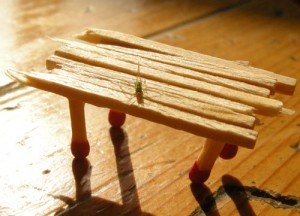 I recently read about a fascinating court case in Kenya relating to a hyena killed by a local family. The deceased beast was awarded legal representation, and indeed his lawyer spoke forcefully and eloquently, winning a ruling that the guilty family pay a number of goats to the hyena’s orphaned young in compensation.
I recently read about a fascinating court case in Kenya relating to a hyena killed by a local family. The deceased beast was awarded legal representation, and indeed his lawyer spoke forcefully and eloquently, winning a ruling that the guilty family pay a number of goats to the hyena’s orphaned young in compensation.
The implications of this are profound and far-reaching, as it suggests a way in which creatures of nature (in this case a hyena) can be given both rights and a voice in a human court of law. Environmentalists have been keen to pick up on this, and to start thinking of it as a model for how other natural world parties suffering harm through human activities may be able to seek redress via existing legal frameworks. If so, activists could not only engage in advocacy, but literally become advocates in a trial of — say — wetland birds vs. an invasive real estate development company. And if legal representation can be extended to hyenas and other wildlife, why not to a river damaged by pollution, or an aggrieved landscape? Would it be possible for the Gulf of Mexico herself, through her lawyers, to sue BP for the oil spill?
 I too was immediately interested in the Kenyan hyena case, though from a slightly different angle. It struck me that if nature and her creatures could take the stand as injured parties, and enjoy full protection of the law, a necessary corollary would be that they could also transgress against it, and therefore themselves face trial. This revelation … was immediately pertinent to my situation as at present I am suffering a series of vicious attacks upon my tulips from a gang of green bugs. The voracious bugs have so far eaten clean through two petals, as well as taking sizable bites out of several others (see photo evidence).
I too was immediately interested in the Kenyan hyena case, though from a slightly different angle. It struck me that if nature and her creatures could take the stand as injured parties, and enjoy full protection of the law, a necessary corollary would be that they could also transgress against it, and therefore themselves face trial. This revelation … was immediately pertinent to my situation as at present I am suffering a series of vicious attacks upon my tulips from a gang of green bugs. The voracious bugs have so far eaten clean through two petals, as well as taking sizable bites out of several others (see photo evidence).
This afternoon I spied a bug strutting cockily across a tulip head, and with the hyena precedent in mind, I avidly seized him and threw him straight in the dock for callous destruction of property.
The case against the defendant was in truth a little tricky. Given what we had on file, it was going to be hard to prove beyond reasonable doubt that this was the bug that had eaten either of the holes, and without a conviction on that front, it would be impossible to secure a capital sentence. After a little reflection however we elected to prosecute for consorting with agents of malfeasance and possible criminal intent, which carries a much lighter burden of proof. We figured we’d have a high likelihood of winning a conviction with at least custodial implications, and given the comparatively short lifespan of green bugs, there was legitimate hope he’d spend the rest of his days behind bars.
Result: a two week (and surely life) sentence.
(And yes, I was both judge and jury, because that’s how justice gets done.)



this is absurd. everyone knows witches are hexing the tulips! africa shows the way.
http://www.theatlantic.com/magazine/archive/2010/06/hex-appeal/8103/
bugs must be crushed! why can’t we vote on whether or not to crush the bug?
the issue of entomological justice goes beyond food and weevil.
hyenas are no laughing matter
Frontier Justice:
“During the trial, Vest stated that he would ‘win the case or apologize to every dog in Missouri.'”
Good to see such a diverse group of new commentators on the site . . .
Julian Barnes had a good bit in 9 1/2 Chapters on an actual trial of a wood worm who chewed through a bishop’s chair. This happened in France, of course, where they also tried and hanged a pig in 1366 because it trampled a young child to death. Before the hanging, the authorities also tortured the pig by inflicting the same fatal injuries suffered by the child: breaking the pig’s legs, slicing open its face, etc. Oddly, they also chose to dress the pig in a man’s clothes at the hanging as a sign that justice is a human realm and that by prosecuting animals we are allowing them to stand beside us for a brief shining moment.
You can take a look at an artist’s vision of the pig hanging *here*